-

人教版新目标初中英语八年级下册It’s a nice day, isn’t it教案2篇
"Hello! Welcome to English class! Introduce yourself. Meet your new classmates." That's what the teacher says. What do you say? "Oh no!" It can be difficult talking to new people. But it can be fun, and you can make friends. How do you do it? Make small talk. Small talk is polite conversation. "Wang Nan is a great pingpang player, isn't she?" "I'd love to meet her, wouldn't you?" "It's been raining a lot, hasn't it?" Tag questions are a form of polite speech. To make small talk successfully, you should know how to make them. You should also know what topics to talk about. Try to learn this unit carefully. The next time you're in English class, you'll find out. Making small talk's easy, isn't it? (“你好!欢迎你!请做一下自我介绍。认识一下你的新同学。”通常在课上老师会这样说。你会说什么呢?“噢,不!”与陌生人谈话太困难了。但是这也很有意思,并且你还能交到朋友。你该怎么做呢?闲聊。闲聊指得是礼貌的对话。“王楠是一个很棒的乒乓球运动员,不是吗?”“我希望自己能认识她,你呢?“今年的雨水很多,不是吗?”反意疑问句是一种礼貌用语。为了使得谈话成功,你应该知道怎样去进行闲聊。你还应该知道与不同的人该谈论什么样的话题。认真的学习这个单元吧,下次在英语课上,你会发现与大家展开谈话是一件很容易的事情,不信我们来试试。)

人教版新目标初中英语八年级下册He said I was hard-working教案2篇
This activity introduces some new vocabulary and provide oral practice using the target language.Task 1 . Ask four students to stand in front of the class, and the teacher asks them the following questions as a reporter.1.What are you going to do when you grow up?2.What are you going to do next week?3.What are going to do after school?The students will give different answers, then ask a good student to report what they said.I am going to e a doctor.What did she say?----------She said she was going to be a doctor.I am going to have a party on Friday night.What did he say?-------He said he was going to have a party on Friday night.I am going to do my homework.What did she say ?------ She said she was going to do her homework.I am going home after school.What did she say?-----She said she was going home after school.Say In this unit we are going to learn to use words like to report what someone said.Task 2. Read the instructions. Then ask a student to read the four questions. And write the words on the Bb. Explain what soap opera is.Task 3. Ask the students to Look at the pictures, point out the TV screens in the picture. Ask one girl to read what Marcia said.What did Marcia say? She said She said she was having a surprise party for Lana on Friday night. Repeat the other pictures in the same way.Activity3. Listen and number the pictures in activity 1a.

人教版新目标初中英语八年级下册How long have you been collecting shells教案2篇
Step Ⅱ Show the new words on the screen and teach the new words. Read the new words to students and ask them to repeat.Step Ⅲ 3aThis activity introduces new vocabulary and provides reading practice using the target language.In this activity first look at the four pictures.T: What can you see in the pictures?Ss: Four snow globes.T: Right. There are four snow globes in the pictures. And what are they?Ss: They are a monster, two polar bears, two penguins and a birthday cake.Write these words on the blackboard: snow globe; monster; polar bear; penguin and birthday cake. Read them to the class and ask students to repeat each one. Make sure students understand each word.Use a computer to show the E-mail message on the screen and read the message to students.Get students to read the e-mail on their own, and then draw lines connecting each snow globe and its description.Correct the answers.AnswersA line should connect each snow globe picture with the words that describe it in the letter.Step Ⅳ 3bThis activity provides writing practice using the target language.First review Activity 2a on Page 47.Then ask students to complete the message according to Activity 2a.Some partial sentences are given to students. Write about one person's collection.When students work, walk around the room checking the progress and offering help as needed.When they finish, ask some students to read their messages to the class.

人教版新目标初中英语八年级下册What were you doing when the UFO arrived教案2篇
(一).知识方面: 1.培养学生能运用过去进行时来描述、谈论过去某个时间正在发生的事情或动作的意识和能力,能就过去某个时间正在发生的动作做出正确的描述。 2.培养学生的想象力和角色扮演的合作能力。 3.培养学生讲述过去发生的事情经过的能力。能正确运用一般过去时来讲述故事。 (二).技能方面: 1.本单元的语言目标是Talk about past events and tell a story(谈论过去的时间和讲述一个故事),围绕这一目标,要涉及句型: What were you doing when the UFO arrived? ----I was sitting in the barber’s chair. The barber was cutting my hair. 因此必须学习standing、studying、cleaning、sleeping、cooking、making、eating、cutting、等表示地点的词,以便为上述句型提供语言材料。2.学习过去进行时的有关知识。Was/were+现在分词,是该时态的表达式。 3.在学习过程中,要区分The boy was walking down the street when the UFO landed.和While the boy was walking down the street, the UFO landed.这两种由when和while引导的状语从句的句型结构。注意它们的不同。

人教版新目标初中英语九年级上册Teenagers should be allowed to choose their own clothes教案2篇
Step 1 Greeting Greet the class and check the homeworkStep 2 A duty report The S on duty gives a report on the rules in his home and lead in 3a “Sun Fei’s and Wu Yu’s rules” Step 3 ReadingSs read the conversation and write the two girls’ rules in the chart. Check the answers.Get Ss to read after the tape and then read aloud by themselves. Then, T explains the language points.Step 4 Pairwork 3bRole play. Use the information in chart to practice with the conversation in 3a covered. They can look at the sample conversation in the right box.Step 5 Task 2 “Who’s the best reporter?”Make a survey by asking any 5 students the questions in the chart in activity 4. Then give out a report about it. See who is the best reporter? And the best reporter will get a nice ball-pen.Step 6 Summary and homework:Write out the report in your exercise-books.Period ThreeStep 1 Greeting and a duty reportThe S gives a duty report talking about his experience of being late for school. Lead in the question “Do you ever get to school late? How often do you get to school late? Always, usually, sometimes, or never?Step 2 1a Get Ss to finish writing.Step 3 Pairwork 1b Get Ss to talk about their answers with their partners using the sample conversation in the box on the right.Step 4 Listening practice2a Lead-in: What will happen if you get to school late? What about Peter? Let’s listen to a conversation between Peter and his father. Get Ss to finish 2a (As usual, for the first time, Ss only listen.) Check the answers.

人教版新目标初中英语九年级上册How do you study for a test教案2篇
内容提示本单元主要内容是学会利用verb十by/with gerund表示方式方法来讨论学习英语的策略,认识自己在学习方面的长处和不足。初步了解现在完成时的结构和用法。现在完成时由助动词have/has+动词的过去分词构成,主要表示过去发生的某一动作对现在仍有影响或造成的后果,常与already,yet,just,ever,never等副词连用。教学目标一、学习目标(Language Goal) 1. Talk about how to study . 学会讨论各种学习方法和策略。2. Find out your suitable learning methods. 找出适合自己的学习方法。 二、语言结构(Language Structures) 1. Verb + by with gerund by+动名词短语 表示“通过…途径,方法” 2. How questions have引导的特殊疑问句 三、目标语言(Target Language) 1. How do you study for tests ? 你是怎样准备考试的?Well , I study by working with my classmates. 哦,我和同学们一起学习。2. Have you ever studied with a group ? 你曾经参加过学习小组吗?Yes , I have . I’ve learned a lot that way . 是的,参加过。通过这种方式我学了许多。

人教版新目标初中英语九年级上册Where would you like to visit教案2篇
The First PeriodⅠ.Teaching Aims and DemandsKnowledge Objects(1) Key Vocabularytiring, educational, fascinating, thrilling, peaceful, exotic, trek, jungle, take it easy, explore, historic, site(2) Target LanguageWhere would you like to go on vacation?I’d like to trek through the jungle, because I like exciting vacations.2. Ability Objects(1)Train students to talk about places they would like to visit with the target language.(2)Train students to describe vacations with different adjectives.(3)Train students' listening skill.3. Moral Object,It′s more interesting to go on vacating somewhere instead of staying at home.Ⅱ. Teaching Key Points1. Key Vocabularytiring, educational, fascinating, thrilling, peaceful, exotic, trek, jungle, take it easy, explore, historic, site2. Target LanguageTalk about different places with the target language.Ⅲ. Teaching Difficult Points1. Describe vacations with different adjectives.2. Talk about different places with the target language.Ⅳ. Teaching Methods1. Teaching by illumination2. Teaching by doing chain drills3. Teaching by pairworkⅤ. Teaching Aids1. A tape recorder2. Some pictures of different places with famous views

人教版新目标初中英语九年级下册We’re trying to save the manatees教案2篇
本单元主要围绕着有关濒临灭绝的动物这一话题,学习了应该怎样保护我们的环境,以及就某一问题展开辩论。目标提示语言目标能够运用所学知识,就某一问题展开辩论。认知目标1、复习一些语法:现在进行时、一般现在时、用used to 表示一般过去时、现在完成时、一般过去时的被动语态。2、学会表达同意和不同意。3、学会以下基本句型:We’re trying to save the manatees.Manatees eat about 100 pounds of food a day.There used to be a lot of manatees.In 1972,it was discovered that they were endangered.Some of the swamps have become polluted.情感目标了解一些濒临灭绝的动物的生活习性和濒临灭绝的原因,教育学生应该如何保护环境。教学提示充分利用多媒体等教学设备,创设与本课话题相关的情境,如各种不同种类的动物、动物园以及有关环境的画画等等。围绕着本单元的教学目标,设计一些贴近学生实际的教学任务,如让学生谈论自己最喜欢的动物,如何拯救濒危动物,如何保护环境等等。让学生根据所学知识,就动物园是否对动物有利以及其他的话题进行辩论。

人教版新目标初中英语八年级上册What are you doing for vacation教案2篇
Teaching goals : 1. Words & phrases: babysit ,get back , fishing , rent , think about , decide(on) , tourist etc. 2. How to talk about future plans . 3. 现在进行时表示将来计划或行动. 4. 特殊疑问句(where , when , how long引导) Important and difficult points : Drills :What are you doing for vacation ? I’m watching TV . When are you going ? I’m going … . How long are you staying ? We’re staying for five days . Teaching aids : cards and a tape ,a large wall calendar . Period 1 Teaching procedures : Step 1Leading in1. Free talk . 2. Put up the wall calendar . T: I’m staying home on Saturday (pointing to next Saturday ).Ss repeat . Ss: I’m staying home on Saturday . T: OK. Today we’ll learn how to talk about future plans. Step 2Pre-task SB Page 13 , 1a . 1. Look at the picture carefully and tell what you see in the picture . 2. Write the activities from the pictures in the box and add some more . 3. Practice reading . Step 3While-task1. Using the activities we write in 1a to make conversations .For example :What are you doing for vacation ? I’m visiting my uncle . 2. Pairwork .Practice in pairs . 3. 用第三人称练习对话.

人教版新目标初中英语八年级上册I’m more outgoing than my sister教案2篇
1 交通工具的比较此活动为小组活动。学生通过讨论找出到达某一城市可乘坐的各种交通工具,并选择最佳出行方式。Teacher:We’re going to Shanghai. How many ways can we use to get there? Yes, there are four ways: by bus, by plane, by train, by ship. Please discuss how you are going to get there.操作建议:(1)学生以小组为单位展开活动,谈论本组所选择的交通工具。(2)各组选代表向全班汇报,阐述本组所选择的交通工具的利和弊。完成任务所需要的语言结构:We can go there by ship. It’s more comfortable and cheaper than any other transportation.We can go there by bus. It’s cheaper but it takes longer time.2 哪个城市更合适?此活动具有挑战性。假设中国要举行2014年世界杯足球赛,分别从历史,人文,天气等方面对各城市(北京,大连,上海,昆明)进行比较,选择最佳举办城市。T: Imagine China is holding the 2014 FIFA World Cup. Which city do you think is the best for the World Cup, Beijing, Dalian, Shanghai or Kunming? Let’s work in groups. If you choose Beijing, please join the Team Red. If you chose Dalian, please join the Team White. If you choose Shanghai, please join the Team Blue. If you choose Kunming, please join the Team Green. Please show us its advantages. Then let’s see which team will win.

部编人教版四年级下册《 宝葫芦的秘密(节选)》教案
一、创设情境,激情导入1.【课件出示2:一只葫芦】看,这是什么?对,一个葫芦,它可不是一个普通的葫芦,它可是有故事的宝葫芦。2.今天,我们来学习《(节选)》。学生齐读课题“宝葫芦的秘密”。请同学们分小组交流一下自己课前阅读到的关于《宝葫芦的秘密》的故事,谈谈自己对宝葫芦的感知。今天,我们就和作家张天翼一起,走进童话故事《宝葫芦的秘密》,走进奇妙的童话世界。板书课题,齐读课题。(板书:宝葫芦的秘密(节选))2.简介作者以及写作背景【出示课件3】
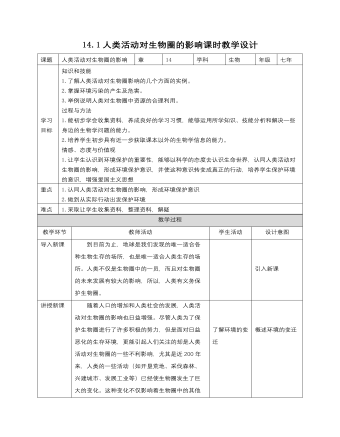
初中生物北师大版七年级下册《第14章第1节人类活动对生物圈的影响》教案
知识和技能 1.了解人类活动对生物圈影响的几个方面的实例。 2.掌握环境污染的产生及危害。 3.举例说明人类对生物圈中资源的合理利用。 过程与方法 1.能初步学会收集资料,养成良好的学习习惯,能够运用所学知识、技能分析和解决一些身边的生物学问题的能力。 2.培养学生初步具有近一步获取课本以外的生物学信息的能力。 情感、态度与价值观 1.让学生认识到环境保护的重要性,能够以科学的态度去认识生命世界,认同人类活动对生物圈的影响,形成环境保护意识,并使这种意识转变成真正的行动,培养学生保护环境的意识,增强爱国主义思想1.认同人类活动对生物圈的影响,形成环境保护意识 2.做到从实际行动出发保护环境1.采取让学生收集资料,整理资料,解疑

中班安全教案:会说话的安全标志
活动目标: 1、鼓励幼儿探索学习,使幼儿认清安全标志,教育幼儿不要玩火、电等危险物品,遵守交通规则。 2、引导幼儿发现尝试,让幼儿知道应该按照安全标志的要求行动,才能既方便自己又不影响集体,培养自我保护意识和能力。 3、通过幼儿自己动手制作安全标志,发展幼儿的想象力和创造力及动手制作的能力。 活动准备: 1、多媒体课件:交通安全、严禁烟火、当心触电、禁止触摸等内容的小故事,并配有关的安全标志。 2、事先让幼儿收集有关的安全标志。 3、每幼儿一套安全标志七种:注意安全、人行横道、步行、禁止通行、严禁烟火、当心触电、禁止触摸。 4、画纸、水彩笔、剪刀等工具材料。
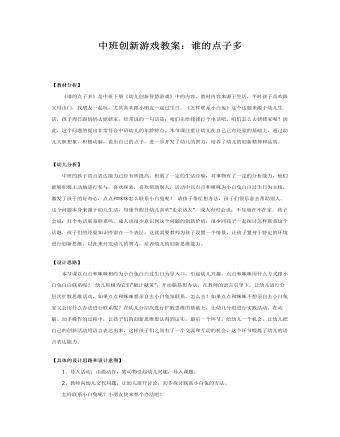
中班创新游戏教案:谁的点子多
【幼儿分析】 中班的孩子语言表达能力已经有所提高,积累了一定的生活经验,对事物有了一定的分析能力,他们能够积极主动地进行参与,喜欢探索,喜欢帮助别人,活动中以点点和咪咪为小白兔白白过生日为主线,激发了孩子的好奇心,点点和咪咪怎么联系小白兔呢?请孩子帮忙想办法,孩子们很乐意去帮助别人。这个问题本身来源于幼儿生活,每逢节假日幼儿喜欢“走亲访友”,成人有时会说:不知道在不在家。孩子会说:打个电话联系联系吗。成人也很少意识到这个问题的创新价值,很少同孩子一起探讨怎样联系这个话题,孩子们的经验知识停留在一个表层,这就需要教师为孩子设置一个情景,让孩子置身于特定的环境进行创新思维,以此来开发幼儿的智力,培养幼儿的创新思维能力。【设计思路】 本节课以点点和咪咪相约为小白兔白白过生日为导入口,引起幼儿兴趣,点点和咪咪用什么方式跟小白兔白白联系呢?幼儿积极为它们“献计献策”,开动脑筋想办法,在教师的语言引导下,让幼儿进行分层次扩散思维活动,如果点点和咪咪想亲自去小白兔家联系,怎么去?如果点点和咪咪不想亲自去小白兔家又会用什么办法进行联系呢?在幼儿分层次进行扩散思维的基础上,让幼儿分组进行实践活动,在动脑、动手操作的过程中,让孩子们的创新思维想法得到证实。最后一个环节,给幼儿一个机会,让幼儿把自己的创新活动用语言表达出来,这样孩子们之间有了一个交流和互动的机会,这个环节锻炼了幼儿的语言表达能力。
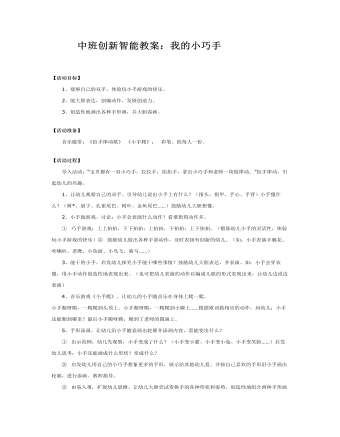
中班创新智能教案:我的小巧手
2、能大胆表达,创编动作,发展创造力。3、创造性地画出各种手形画,并大胆添画。【活动准备】 音乐磁带:《拍手律动歌》《小手爬》; 彩笔、纸每人一份。【活动过程】 导入活动:“宝贝都有一双小巧手,拉拉手,拍拍手,拿出小巧手和老师一块做律动。”拍手律动,引起幼儿的兴趣。1、让幼儿观察自己的双手。引导幼儿说出小手上有什么?(指头、指甲、手心、手背)小手像什么?(树*、扇子、孔雀尾巴、树叶、金鱼尾巴……)鼓励幼儿大胆想像。2、小手做游戏。讨论:小手会表演什么动作?看谁想得动作多。① 巧手游戏:上上拍拍,下下拍拍;上拍拍,下拍拍;上下拍拍。(锻炼幼儿小手的灵活性,体验玩小手游戏的快乐)② 鼓励幼儿做出各种手部动作,及时表扬有创新的幼儿。(如:小手表演手腕花、吹喇叭、老鹰、小鱼游、小鸟飞、骑马……)3、能干的小手。启发幼儿探究小手能干哪些事情?鼓励幼儿大胆表达、并表演。如:小手会穿衣服,用小手动作创造性地表现出来。(也可把幼儿表演的动作以编成儿歌的形式表现出来,让幼儿边说边表演)
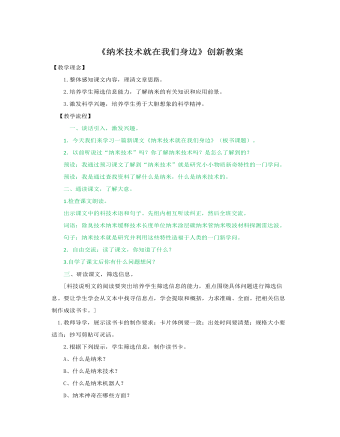
部编人教版四年级下册《 飞向蓝天的恐龙》创新教案
【教学理念】 1.整体感知课文内容,理清文章思路。2.培养学生筛选信息能力,了解纳米的有关知识和应用前景。3.激发科学兴趣,培养学生勇于大胆想象的科学精神。【教学流程】一、谈话引入,激发兴趣。1.今天我们来学习一篇新课文《纳米技术就在我们身边》(板书课题)。2.以前听说过“纳米技术”吗?你了解纳米技术吗?是怎么了解到的?预设:我通过预习课文了解到“纳米技术”就是研究小小物质新奇特性的一门学问。预设:我是通过查找资料了解什么是纳米,什么是纳米技术的。二、通读课文,了解大意。1.检查课文朗读。出示课文中的科技术语和句子。先组内相互听读纠正,然后全班交流。词语:除臭技术纳米缓释技术长度单位纳米涂层碳纳米管纳米吸波材料探测雷达波。句子:纳米技术就是研究并利用这些特性造福于人类的一门新学问。2.自由交流:读了课文,你知道了什么?3.自学了课文后你有什么问题想问?
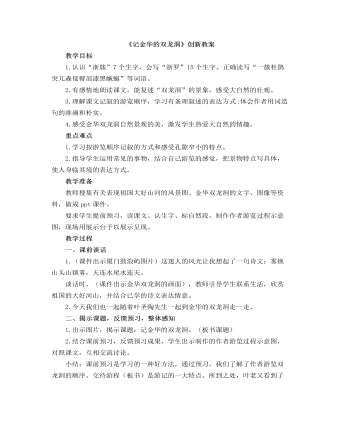
部编人教版四年级下册《记金华的双龙洞》创新教案
教学目标1.认识“浙簇”7个生字,会写“浙罗”15个生字。正确读写“一簇杜鹃突兀森郁臀部漆黑蜿蜒”等词语。2.有感情地朗读课文,能复述“双龙洞”的景象,感受大自然的壮观。3.理解课文记叙的游览顺序,学习有条理叙述的表达方式;体会作者用词造句的准确和朴实。4.感受金华双龙洞自然景观的美,激发学生热爱大自然的情趣。重点难点1.学习按游览顺序记叙的方式和感受孔隙窄小的特点。2.指导学生运用常见的事物,结合自己游览的感觉,把景物特点写具体,使人身临其境的表达方式。教学准备教师搜集有关表现祖国大好山河的风景图、金华双龙洞的文字、图像等资料,做成ppt课件。要求学生提前预习,读课文、认生字、标自然段,制作作者游览过程示意图,现场用展示台予以展示呈现。
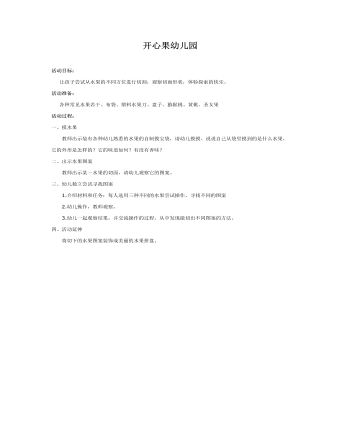
中班科学:水果里的图案课件教案
活动准备: 各种常见水果若干、布袋、塑料水果刀、盘子、猕猴桃、黄桃、圣女果活动过程:一、摸水果 教师出示装有各种幼儿熟悉的水果的自制摸宝袋,请幼儿摸摸、说说自己从袋里摸到的是什么水果,它的外形是怎样的?它的味道如何?有没有香味?二、出示水果图案 教师出示某一水果的切面,请幼儿观察它的图案。
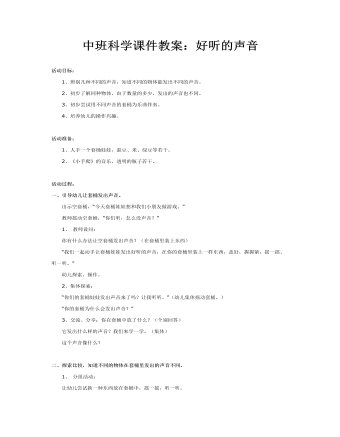
中班科学课件教案:好听的声音
2、初步了解同种物体,由于数量的多少,发出的声音也不同。3、初步尝试用不同声音的套桶为乐曲伴奏。4、培养幼儿的操作兴趣。 活动准备:1、人手一个套桶娃娃,蚕豆、米、绿豆等若干。2、《小手爬》的音乐,透明的瓶子若干。 活动过程:一、引导幼儿让套桶发出声音。 出示空套桶,“今天套桶娃娃想和我们小朋友做游戏。” 教师摇动空套桶,“你们听,怎么没声音?”1、教师设问: 你有什么办法让空套桶发出声音?(在套桶里装上东西)“我们一起动手让套桶娃娃发出好听的声音,在你的套桶里装上一样东西,盖好,握握紧,摇一摇、听一听。” 幼儿探索、操作。
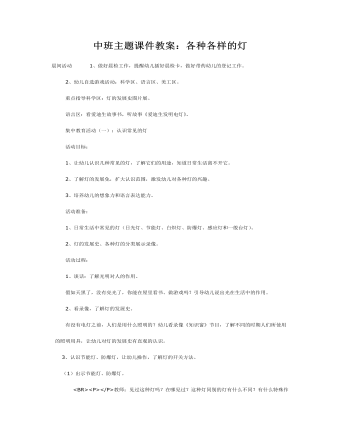
中班主题课件教案:各种各样的灯
2、幼儿自选游戏活动:科学区、语言区、美工区。 重点指导科学区:灯的发展史图片展。 语言区:看爱迪生故事书,听故事《爱迪生发明电灯》。 集中教育活动(一):认识常见的灯 活动目标: 1、让幼儿认识几种常见的灯,了解它们的用途,知道日常生活离不开它。 2、了解灯的发展免,扩大认识范围,激发幼儿对各种灯的兴趣。 3、培养幼儿的想象力和语言表达能力。 活动准备: 1、日常生活中常见的灯(日光灯、节能灯、白炽灯、防爆灯、感应灯和一般台灯)。 2、灯的发展史、各种灯的分类展示录像。 活动过程: 1、谈话:了解光明对人的作用。 假如天黑了,没有亮光了,你能在屋里看书、做游戏吗?引导幼儿说出光在生活中的作用。 2、看录像,了解灯的发展史。 有没有电灯之前,人们是用什么照明的?幼儿看录像《知识窗》节目,了解不同的时期人们所使用 的照明用具,让幼儿对灯的发展史有直观的认识。 3、认识节能灯、防爆灯,让幼儿操作,了解灯的开关方法。 (1)出示节能灯、防爆灯。 教师:见过这种灯吗?在哪见过?这种灯同别的灯有什么不同?有什么特殊作用? (2)你知道怎样才能使它们亮起来吗?(通电打开开关)请幼儿实际操作将活动室的灯打开、关上。 (3)幼儿探索尝试感应台灯和一般台灯开关方法的不同。